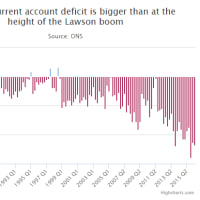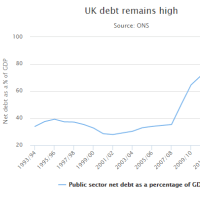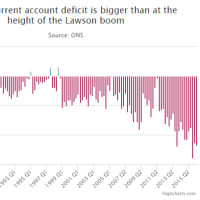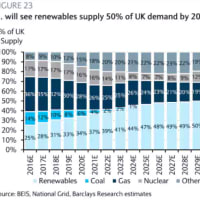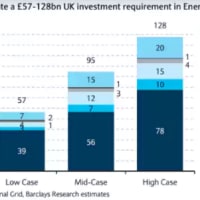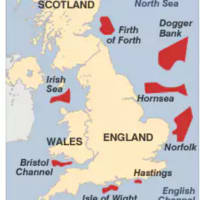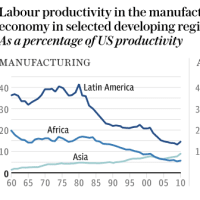古いです。
時間の問題ではなく、退屈して途中で投げ出したトリウムネタの記事です。
ごめんねー。
China blazes trail for 'clean' nuclear power from thorium
(中国、トリウムの「クリーンな」原子力ゲットの道を突き進む)
By Ambrose Evans-Pritchard
Telegraph: 9:30PM GMT 06 Jan 2013


時間の問題ではなく、退屈して途中で投げ出したトリウムネタの記事です。
ごめんねー。
China blazes trail for 'clean' nuclear power from thorium
(中国、トリウムの「クリーンな」原子力ゲットの道を突き進む)
By Ambrose Evans-Pritchard
Telegraph: 9:30PM GMT 06 Jan 2013
The Chinese are running away with thorium energy, sharpening a global race for the prize of clean, cheap, and safe nuclear power. Good luck to them. They may do us all a favour.
中国勢がトリウム開発でぶっちぎりです。クリーンでチープでセーフな原子力を求める世界的な争奪戦を激化させています。幸運を祈ります。僕らのためになるかもしれませんし。
Princeling Jiang Mianheng, son of former leader Jiang Zemin, is spearheading a project for China's National Academy of Sciences with a start-up budget of $350m.
江沢民元首席の息子、江綿恒氏が立ち上げ予算3億5,000万ドルという中国科学院のプロジェクトの陣頭指揮を執っています。
He has already recruited 140 PhD scientists, working full-time on thorium power at the Shanghai Institute of Nuclear and Applied Physics. He will have 750 staff by 2015.
江氏は既に140名の博士号を持つ科学者を採用しており、 中国科学院上海応用物理研究所でトリウム・パワー研究にフルタイムで取り組んでいます。
2015年までには750名までに増員するそうです。
The aim is to break free of the archaic pressurized-water reactors fueled by uranium -- originally designed for US submarines in the 1950s -- opting instead for new generation of thorium reactors that produce far less toxic waste and cannot blow their top like Fukushima.
目指すは、ウランを燃料とする旧式な加圧式軽水炉(そもそも1950年代に米海軍の潜水艦向けに設計されました)を捨てて、廃棄物の危険性が遥かに低く、福島原発のように吹っ飛ぶことのない、新型トリウム原子炉の開発です。
"China is the country to watch," said Baroness Bryony Worthington, head of the All-Parliamentary Group on Thorium Energy, who visited the Shanghai operations recently with a team from Britain's National Nuclear Laboratory.
「中国は観察すべき国です」と英国の国立原子力研究所の派遣団と共に先日上海を訪れた、トリウム・エネルギーに関する超党派委員会の代表を務めるバロネス・ブリオニー・ワージントン貴族議員は言いました。
"They are really going for it, and have talented researchers. This could lead to a massive break-through."
「彼らは本気ですし、才能豊かな研究者もいます。これは大変なブレークスルーをもたらすかもしれません」
The thorium story is by now well-known. Enthusiasts think it could be the transforming technology needed to drive the industrial revolutions of Asia -- and to avoid an almighty energy crunch as an extra two billion people climb the ladder to western lifestyles.
トリウム物語は今や有名です。
アジアの産業革命を推進するために必要なテクノロジーを変えるかもしれない、また、更に20億人の生活水準が西側のライフスタイルに近付くにつれ生じる強烈なエネルギー不足を回避するかもしれない、とトリウム信奉者は考えています。
At the least, it could do for nuclear power what shale fracking has done for natural gas -- but on a bigger scale, for much longer, perhaps more cheaply, and with near zero CO2 emissions.
少なくとも、トリウムはシェールの水圧砕破技術が天然ガスにもたらした効果を、より大きな規模で、よりずっと長期的に、恐らくより安価に、そして二酸化炭素排出量ほぼ皆無で、原子力に与える可能性があります。
The Chinese are leading the charge, but they are not alone. Norway's Thor Energy began a four-year test last month with Japan's Toshiba-Westinghouse to see whether they could use thorium at Norway's conventional Halden reactor in Oslo.
中国勢が先頭に立っているとはいえ、彼らだけではありません。
ノルウェーのThor Energy社は先月、日本の東芝ウェスティンハウス社と、ノルウェー、オスロにある従来型のハルデン原子炉でトリウムの利用が可能かどうかを確認する、4年に亘る実験を開始しました。
The Japanese are keen to go further, knowing they have to come up with something radically new to regain public trust and save their nuclear industry.
日本勢は更なる前進を強く望んでいます。
世間の信頼を取り戻し、原子力産業を救うためには、何か抜本的に新しいものを生み出さなければならないとわかっているのです。
Japan's International Institute for Advanced Studies (IIAS) -- now led by thorium enthusiast Takashi Kamei -- is researching molten salt reactors that use liquid fuel.
国際高等研究所事務局(現在はトリウム信奉者の亀井敬史氏が率いています)は、液体燃料を用いる熔融塩炉を研究しています。
Is this what Premier Shinzo Abe meant when he revealed before Christmas that he planned to relaunch nuclear power in Japan with "entirely different" technology? We will find out.
安倍晋三総理が、「全く異なる」技術を以って日本で原発を再開する計画だ、とクリスマス前に発表した際に言っていたのは、こういうことでしょうか?
その内明らかになりましょう。
The Chinese aim to beat them to it. Technology for the molten salt process already exists. The Oak Ridge National Laboratory in Tennessee built such a reactor in the 1960s. It was shelved by the Nixon Administration. The Pentagon needed plutonium residue from uranium to build nuclear bombs. The imperatives of the Cold War prevailed.
中国勢が目指すのは日本勢の打倒です。
溶融塩炉処理の技術は既に存在しています。
テネシー州にあるオークリッジ国立研究所は1960年代にこの種の原子炉を作りました。
ニクソン政権が棚上げにしていたのです。
国防総省は原子爆弾を作るためにウランから出るプルトニウム残留物が必要でした。
冷戦時代の課題が優先されたのです。
The thorium blueprints gathered dust in the archives until retrieved and published by former Nasa engineer Kirk Sorensen. The US largely ignored him: China did not.
NASAの元エンジニア、カーク・ソレンセン氏が引っ張り出して公表するまで、トリウム計画は書庫で埃を被っていました。
米国は彼をほぼ無視しましたが、中国はしませんでした。
Mr Jiang visited the Oak Ridge labs and obtained the designs after reading an article in the American Scientist two years ago extolling thorium. His team concluded that a molten salt reactor -- if done the right way -- may answer China's prayers.
江氏は2年前にトリウムを称賛するアメリカン・サイエンティスト誌の記事を読んで、オークリッジの研究所を訪れて設計図を手に入れました。
江氏のチームは、溶融塩原子炉は(正しい方法で行えば)中国の祈りに答えてくれるかもしれないとの結論に達しました。
Mr Jiang says China's energy shortage is becoming "scary" and will soon pose a threat to national security. It is no secret what he means. Escalating disputes with with India, Vietnam, the Philippines, and above all Japan, are quickly becoming the biggest threat to world peace. It is a resource race compounded by a geo-strategic struggle, with echoes of the 1930s.
江氏曰く、中国のエネルギー不足は「恐ろしい」ものになりつつあり、間もなく国家安全保障の脅威になるだろうとのことです。
彼が言っていることは秘密でも何でもありません。
インド、ベトナム、フィリピン、そして何よりも日本と悪化する紛争は、世界平和にとって最大の脅威へと急速に変わりつつあります。
これは1930年代を彷彿とさせる地理戦略的争いによって助長された資源の奪い合いなのです。
His mission is to do something about China's Achilles Heel very fast. The Shanghai team plans to build a tiny 2 MW plant using liquid flouride fuel by the end of the decade, before scaling up to commercially viable size over the 2020s. It is also working on a pebble-back reactor.
江氏のミッションは、中国のアキレス腱に極めて迅速に対応することです。
上海の研究チームは、2020年代に商業用サイズにスケールアップする前に、2020年までに液体フッ素を燃料とする小型の2MWのプラントを建設する計画です。
また、ペブルベッド型原子炉の研究も進めています。
He estimates that China has enough thorium to power its electricity needs for "20,000 years". So does the world. The radioactive mineral is scattered across Britain. The Americans have buried tonnes of it, a hazardous by-product of rare earth metal mining.
江氏の試算では、中国には「2万年分」の電力を得られるだけのトリウムがあるそうです。
世界も同様です。
英国全土にこの放射性物質は散在しています。
米国にもこの希土類金属採掘の危険な副産物はトン単位で埋蔵されています。
China is already building 26 conventional reactors by 2015, with a further 51 planned, and 120 in the pipeline, but these have all the known drawbacks, and rely on imported uranium.
中国は2015年までに完成すべく従来型の原子炉26基を建設中で、更に51基が計画され、120基がパイプラインに乗っていますが、これらの原子炉にはよく知られた欠点があり、輸入ウランに依存しています。
The beauty of thorium is that you cannot have a Fukushima disaster. Professor Robert Cywinksi from Huddersfield University, who anchor's the UK's thorium research network ThorEA, said the metal must be bombarded with neutrons to drive the process. "There is no chain reaction. Fission dies the moment you switch off the photon beam," he said.
トリウムの素晴らしいところは、福島原発のような事故が起こらないことです。
ハダーズフィールド大学のロバート・シウィンスキー教授は、英国のトリウム研究ネットワーク、ThorEAの要ですが、同教授曰く、反応させるためにはトリウムに中性子をぶつけまくらなければならないそうです。
「連鎖反応はありません。フォトン・ビームを止めるや否や反応は停止してしまいます」とのこと。
His team is working on an accelerator driven subcritical reactor. "Peope are beginning to realize that uranium isn't sustainable. We're going to have to breed new nuclear fuel. If we are going to the trouble of breeding, we could start to use thorium instead, without introducing plutonium into the cycle," he said.
江氏のチームは、加速器駆動未臨界炉を研究しています。
「皆、ウランは持続可能ではないと気付き始めている。我々は新しい核燃料を生み出さなければならなくなる。これの困難に取り組むなら、プルトニウムをサイクルに導入するのではなく、代わりにトリウムを使い始められるだろう」
Thorium has its flaws. The metallurgy is complex. It is "fertile" but not fissile, and has to be converted in Uranium 233. Claims by the International Atomic Energy Institute in 2005 that it has "intrinsic resistance" to proliferation but have since been qualified. It could be used as feedstock for bombs, though not easily.
トリウムにも欠点はあります。
冶金が複雑なのです。
核分裂性ではなく「核分裂性アイソトープに転換可能」であり、ウラン233に転換しなければなりません。
IAEAは2005年にトリウムは拡散に「固有抵抗」があると主張しましたが、その後条件が付けられました。
容易ではありませんが、トリウムは原子爆弾の材料としても利用出来るのです。
Yet it leaves far less toxic residue. Most of the mineral is used up in the fission process, while uranium reactors use up just 0.7pc. It can even burn up existing stockpiles of plutonium and hazardous waste.
とはいえ、有害な残留物は遥かに少なくなります。
鉱物の大半は核分裂で使い果たされますが、ウランを燃料とする原子炉では僅か0.7%しか使われません。
更には、既存のプルトニウムや有害な廃棄物まで燃やし尽くせるのです。
Cambridge scientists published a tantalising study in the Annals of Nuclear Energy in February showing that it is possible to "achieve near complete transuranic waste incineration" by throwing the old residue into the reactor with thorium.
ケンブリッジ大学の科学者等は2月に、Annals of Nuclear Energy誌で魅惑的な研究論文を発表し、トリウム原子炉に古い残留物を投棄することで「ほぼ完全に超ウラン廃棄物を作る」ことが可能だとしめしました。
In other words, it can help clean up the mess left by a half a century of nuclear weapons and uranium reactors, instead of transporting it at great cost to be encased in concrete and buried for milennia. It is why some 'greens' such as Baroness Worthington -- a former Friends of the Earth activist -- are embracing thorium. Though there are other reasons.
言い換えれば、核兵器とウラン原子炉が半世紀に亘って生み出した廃棄物を、巨額のコストをかけてコンクリート詰めにして100万年埋蔵する代わりに、処分することが出来るのです。
だからこそ、バロネス・ブリオニー・ワージントン(元フレンズ・オブ・ジ・アースの活動家)のような「エコ派」の一部がトリウムに賛成しているのです。
尤も、他の理由もありますが…。
The thorium molten salt process takes place at atmospheric pressures. It does not require the vast domes of conventional reactors, so costly, and such an eyesore.
トリウムの溶融塩処理は大気圧で行われます。
既存の原子炉のように、高価で無様な巨大ドームは不要なのです。
You could build pint-size plants largely below ground, less obtrusive than a shopping mall, powering a small town the size of Tunbridge Wells or Colchester. There would be shorter transmission lines, less leakage, and less risk of black-outs. The elegance is irresistible.
パイント・グラス(約500cc)サイズの原子炉を主に地下に、ショッピングモールよりも控えめに作り、タンブリッジ・ウェルズかコルチェスター規模の小さな町に十分な電力を送ることが出来るのです。
送電線は短縮され、漏電は減少し、停電リスクも低下するでしょう。
抵抗し難い素晴らしさです。
Mr Sorensen says his group Flibe Energy is exploring 250 MW reactors that could be tailor-made to power a single steel plant. Imagine the benefits for China, which drives is collosal steel industry -- 40pc of the world's total -- with high-polluting coking coal, much of it shipped from distant mines in lorries.
ソレンセン氏によれば、彼のグループ、Filbe Energyは鉄工所一つ分の電力をテイラーメイド出来る250MW原子炉を研究しているとのことです。
環境汚染が酷く、その大半を遠方の炭鉱からトラックで運ばなければならない石炭を燃料とする巨大鉄鋼産業(世界の4割を占めます)を推し進める中国にとってどれほどの恩恵になるか想像してみて下さい。
Mr Sorensen said his molten salt design could not cause a meltdown because it never reaches a high enough temperature to melt the nickel-alloy vessel.
ソレンセン氏は、ニッケル合金を融かせるだけの高温に達することがないので、彼の溶融塩原子炉はメルトダウンしないと言います。
If there is an emergency, a plug melts and the salts drain into a pan. "The reactor saves itself," he said.
緊急事態が起これば、プラグが溶けて塩が流れ出します。
「この原子炉は自救式だ」そうです。
Major players in the nuclear industry have had a vested interest in blocking thorium. They have huge sunk costs in the old technology, and they have bent the ear of cash-strapped ministers.
原子力産業の主要関係者には、トリウム原子炉を阻止するだけの巨大な利権があります。
旧テクノロジーの埋没費用は巨額に上っており、金欠大臣達を口説きました。
The hesitance of governments is understandable, but the costs are going to hit whatever they do. The overrun fiasco of Areva's Olkilouto reactor in Finland is not pretty either, and the UK's new reactor plans for Hinkley tempt fate as well.
政府が二の足を踏むのは分かりますが、何をしようがコストは増えます。
フィンランドにあるアレバ社の原子炉の遅延問題も無様ですし、英国がヒンクリーに建設を計画している新しい原子炉も同様の運命を辿るでしょう。
China's dash for thorium is now changing the game. Britain has begun to hedge its bets. Chief scientific adviser Sir John Beddington said in September that the benefits of thorium are "often overstated" but conceded "theoretical advantages regarding sustainability, reducing radiotoxicity and reducing proliferation risk".
中国のトリウム開発は今やゲームを変えつつあります。
英国はヘッジをし始めました。
チーフ・サイエンティフィック・アドバイザーのサー・ジョン・ベディントンは9月に、トリウムの利益は「誇張されることが多い」としたものの、「持続可能性、放射能毒性の軽減、核拡散リスクの軽減に関する理論的強み」を認めました。
He noted rising global interest. "It may therefore be judicious for the UK to maintain a low level of engagement in thorium fuel cycle research." A bit lame for a country that once pioneered nuclear physics, but better than nothing.
サー・ジョンは、世界的に関心が高まっていることを指摘しました。
「従って、トリウム燃料サイクル研究に若干関与し続けることは、英国にとって賢明なことかもしれない」。
原子物理学の先駆者であった国としてはやや遅い気もしますが、何もしないよりはましです。
Xu Hongjie, the director of the Shanghai project, says the US Energy Department has begun to take a close interest in China's plans and is now seeking "collaberation". He is also talking to the Russians. The Indians are kicking their thorium programme into higher gear.
上海プロジェクトのディレクター、Xu Hongjie氏は、米国エネルギー庁が中国の計画に注目し始め、今では「協力」を求めていると言います。
また、ロシアについても言及しています。
インドは自国のトリウム開発を強化しています。
You can view it as a technology race or a joint venture in the common interest. It hardly matters which. If the Chinese can crack thorium, the world will need less oil, coal, and gas than feared. Wind turbines will vanish from our landscape. There will less risk of a global energy crunch, less risk of resource wars, and less risk of a climate tipping point.
これをテクノロジー競争や共通利益を目指す合弁事業と見なすことも出来るでしょう。
どちらでも大した違いはありません。
中国勢がトリウム開発に成功出来るなら、世界が必要とする石油、石炭、ガスは懸念されているよりも少なくなります。
風力発電のタービンも景色から姿を消すでしょう。
世界的エネルギー不足の危険性も減りますし、資源戦争のリスクも減りますし、気候変動の危機的ポイントが訪れるリスクも減ります。
Who can object to that?
誰がそれに反対出来るでしょう?











